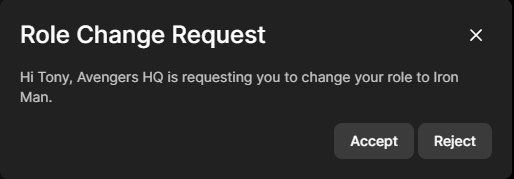Change Role

Role is a powerful concept that takes a lot of complexity away in handling permissions and supporting features like breakout rooms. Learn more about roles here.
Every peer is associated with a role. The HMSRole object can be used to know the following:
- Check what this role is allowed to publish. i.e can it send video (and at what resolution)? can it send audio? can it share screen? This can be discovered by using
selectIsAllowedToPublishto display the UI appropriately. - Check which other roles can this role subscribe to. This is internally taken care of by the 100ms infra and sdk, and your UI will only get tracks as per allowed subscriptions.
role.subscribeParamscan be used to get details. - Check what actions this role can perform. i.e can it change someone else's current role, end meeting, remove someone from the room. This can be discovered by using the
selectPermissionsselector.
In certain scenarios you may want to change someone's role. Imagine an audio room with 2 roles "speaker" and "listener". Only someone with a "speaker" role can publish audio to the room while "listener" can only subscribe. Now at some point "speaker" may decide to nominate some "listener" to become a "speaker". This is where the changeRole API comes in.
To invoke the api you will need 3 things.
remotePeerId: The remote peer ID whose role you want to change.toRoleName: The target role name.force: Whether you want to change their role without asking them or give them a chance to accept/reject.
All the peers that are in the current room are accessible via selectPeers selector.
A list of all available role names in the current room can be accessed via the selectAvailableRoleNames selector. You can further use the selectRoleByRoleName
selector to get the full role object for a role name which will have the role's permissions and what they're allowed to do.
Once you have all you can invoke:
function changeRole(forPeerId: string, toRoleName: string, force: boolean) { hmsActions.changeRole(forPeerId, toRoleName, force); }
The force parameter in changeRole, when false, is a polite request: "Would you like to change your role from listener to speaker?" which can be ignored by the other party.
The way it works is the other party will first receive a request which they can accept or reject.
function handleRoleChangeRequest(request) { if (!request) { return; } console.log(`${request.requestedBy.name} requested role change to - ${request.role.name}`); // decide what to do with the request const accept = shouldAccept(request); if (accept) { hmsActions.acceptChangeRole(request); } else { hmsActions.rejectChangeRole(request); } } hmsStore.subscribe(handleRoleChangeRequest, selectRoleChangeRequest);
If the request is accepted, the peer.roleName field in the store will update for all peers which should update their UI as well.
Imagine that the newly nominated speaker is not behaving nicely and we want to move him back to listener without a prompt.
This is where the force parameter comes in. When it is set to true the other party will not receive a confirmation roleChangeRequest
but instead will straight away receive a new set of updated permissions and stop publishing.
